HTPC - TV Tuner Reviews
by Jarred Walton on December 7, 2005 12:05 AM EST- Posted in
- Smartphones
- Mobile
MyHD MDP-130
The Macro Image Technology (MIT) MyHD MDP-130 has a lot in common with the Fusion5 Gold. It, too, allows the viewing of QAM encoded channels as well as analog TV and OTA DTV broadcasts. You might be interested to know that both the Fusion5 and MyHD originate in Korea, apparently because Korea is one of the few countries that uses similar television standards to the US. Many of the bugs with the Fusion5 - and even MyHD - stem from the fact that Korea has far more strict standards in place for digital TV signals, so there aren't as many special cases that need to be programmed into the software. Besides the features and country of origin, there are quite a few other differences in the cards. Here's a shot of the card before we continue.
It should be immediately clear that this is a much larger card than the Fusion5. The added size comes with added features, so it's a worthwhile upgrade if you can afford it. First, two antenna inputs are supported, so you can connect an OTA DTV antenna as well as a cable connection, or an analog antenna and a digital antenna, or whatever other combination that you might come up with. While there are two inputs, it's important to note that this is not a dual-tuner card - you can't watch one channel and record another, or record two channels simultaneously. (You can't even use the software to watch one recorded broadcast while recording a new broadcast, though that feature appears to be on the wish list for both the Fusion and the MyHD. You can use a second application, but that's not the same thing.)
The major difference between the Fusion and the MyHD is that where the Fusion5 (and many other TV tuners) are predominantly software products for decoding, the MyHD features hardware-based decoding. The benefit of hardware decoding is that processor speed requirements are very reasonable - in fact, a second-hand PC is probably sufficient. The minimum system requirements list a Pentium II 400 MHz with 64MB of RAM. We didn't test in anything anywhere near that outdated, but we can say that CPU usage with our Sempron system remained very low. Even with the overlay window stretched to fill the 1280x720 output (which requires more processing power), CPU usage is well below 20% when watching digital channels. Analog channels are a different story, which we'll get to in a moment.
Like all the other cards in this article, a remote is included with the MyHD along with a USB receiver. The MyHD is the smallest of the remotes, and it also omits many of the extra buttons that are present on the other remotes. Personally, the lack of a "PC Power" button is appreciated. If you want the PC to enter sleep mode or shut down, you can set that as a configuration option, and that's the best way to approach this feature. The only button that I never found useful is the "subchannel" button. If you disable the virtual channel mode, it allows you to switch between sub-channels. I preferred the virtual channel mode.
The rear of the card features a large output connection that attaches to the above cable. Similar to other pass-thru cards in the past, a three-port cable that connects to the video card's VGA port as well as the MyHD card, and the display is provided. (This cable is often jokingly referred to as the "octopus cable".) S-VIDEO and Composite inputs are also an option on a fourth connection, though we didn't use those since we were connected to an HDTV.
Switching to "HD mode" - either by pressing the "HD" button on the remote or by double-clicking the video window - bypasses the graphics card output and uses the output of the MyHD card instead. The software allows you to configure the resolution and type of display used, with most standard resolutions available. (You can find the complete list of supported resolutions at Digital Connections - the specs listed there are actually more accurate than the specs on the MIT site, in case you were wondering.)
The problem with the HD mode is that it only works properly with a VGA display or component connections (a separate VGA-to-component cable is required, but you can get it packaged with the card at many places), but not with a DVI output. If you want to use a DVI port, the solution is to get the additional DVI daughtercard pictured above, the MDP-130DVI. We'd prefer to get everything in one package, and a single slot solution would be nice. However, finding room for both VGA and DVI outputs along with the coaxial connections is almost impossible. A breakout box could suffice, but that would increase costs for all users rather than only those who want to use a DVI port.
Besides VGA or DVI (with daughtercard), there are additional ways of using the MyHD card. As we discussed earlier, ATI cards had a problem with the DVI connection when hooked up to an HDTV. That problem occurs with or without the MDP-130DVI card, making ATI+DVI an unacceptable solution in our view. If you want to get creative, you can try chaining together a few dongles and cables to get the component output of an ATI card to route through the VGA connections of the MyHD "octopus" cable. We didn't try that, and it may not actually work.
If you want something that will work, pick up a transcoder that will convert the VGA RGBHV signal into a component signal. The Audio Authority 9A60 will handle that task, and while it costs more than the DVI daughtercard, it is also more flexible. Feeding the VGA output of the octopus into the transcoder and then using component cables to connect the transcoder to the display will then work.
We tested with both the DVI card as well as the VGA connection going to a PC monitor. For the VGA connection, any standard PC monitor can be used. For someone in a small apartment or college dorm, that might be sufficient, but watching TV on a computer display generally isn't as pleasing as using a larger TV. You can also use the MyHD in dual-display mode, with a standard monitor and either the DVI, VGA, or VGA-to-component cable to connect to a secondary display. If you have a PC near your HDTV, you can even have MyHD showing and/or recording a broadcast while the PC is used for other tasks without difficulty.
The Macro Image Technology (MIT) MyHD MDP-130 has a lot in common with the Fusion5 Gold. It, too, allows the viewing of QAM encoded channels as well as analog TV and OTA DTV broadcasts. You might be interested to know that both the Fusion5 and MyHD originate in Korea, apparently because Korea is one of the few countries that uses similar television standards to the US. Many of the bugs with the Fusion5 - and even MyHD - stem from the fact that Korea has far more strict standards in place for digital TV signals, so there aren't as many special cases that need to be programmed into the software. Besides the features and country of origin, there are quite a few other differences in the cards. Here's a shot of the card before we continue.
It should be immediately clear that this is a much larger card than the Fusion5. The added size comes with added features, so it's a worthwhile upgrade if you can afford it. First, two antenna inputs are supported, so you can connect an OTA DTV antenna as well as a cable connection, or an analog antenna and a digital antenna, or whatever other combination that you might come up with. While there are two inputs, it's important to note that this is not a dual-tuner card - you can't watch one channel and record another, or record two channels simultaneously. (You can't even use the software to watch one recorded broadcast while recording a new broadcast, though that feature appears to be on the wish list for both the Fusion and the MyHD. You can use a second application, but that's not the same thing.)
The major difference between the Fusion and the MyHD is that where the Fusion5 (and many other TV tuners) are predominantly software products for decoding, the MyHD features hardware-based decoding. The benefit of hardware decoding is that processor speed requirements are very reasonable - in fact, a second-hand PC is probably sufficient. The minimum system requirements list a Pentium II 400 MHz with 64MB of RAM. We didn't test in anything anywhere near that outdated, but we can say that CPU usage with our Sempron system remained very low. Even with the overlay window stretched to fill the 1280x720 output (which requires more processing power), CPU usage is well below 20% when watching digital channels. Analog channels are a different story, which we'll get to in a moment.
 |
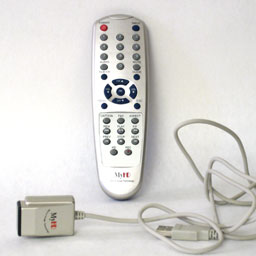 |
| Click to enlarge. | |
Like all the other cards in this article, a remote is included with the MyHD along with a USB receiver. The MyHD is the smallest of the remotes, and it also omits many of the extra buttons that are present on the other remotes. Personally, the lack of a "PC Power" button is appreciated. If you want the PC to enter sleep mode or shut down, you can set that as a configuration option, and that's the best way to approach this feature. The only button that I never found useful is the "subchannel" button. If you disable the virtual channel mode, it allows you to switch between sub-channels. I preferred the virtual channel mode.
The rear of the card features a large output connection that attaches to the above cable. Similar to other pass-thru cards in the past, a three-port cable that connects to the video card's VGA port as well as the MyHD card, and the display is provided. (This cable is often jokingly referred to as the "octopus cable".) S-VIDEO and Composite inputs are also an option on a fourth connection, though we didn't use those since we were connected to an HDTV.
Switching to "HD mode" - either by pressing the "HD" button on the remote or by double-clicking the video window - bypasses the graphics card output and uses the output of the MyHD card instead. The software allows you to configure the resolution and type of display used, with most standard resolutions available. (You can find the complete list of supported resolutions at Digital Connections - the specs listed there are actually more accurate than the specs on the MIT site, in case you were wondering.)
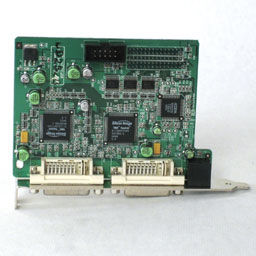 |
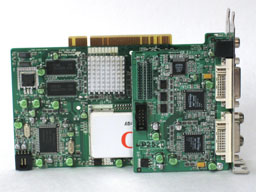 |
| Click to enlarge. | |
The problem with the HD mode is that it only works properly with a VGA display or component connections (a separate VGA-to-component cable is required, but you can get it packaged with the card at many places), but not with a DVI output. If you want to use a DVI port, the solution is to get the additional DVI daughtercard pictured above, the MDP-130DVI. We'd prefer to get everything in one package, and a single slot solution would be nice. However, finding room for both VGA and DVI outputs along with the coaxial connections is almost impossible. A breakout box could suffice, but that would increase costs for all users rather than only those who want to use a DVI port.
Besides VGA or DVI (with daughtercard), there are additional ways of using the MyHD card. As we discussed earlier, ATI cards had a problem with the DVI connection when hooked up to an HDTV. That problem occurs with or without the MDP-130DVI card, making ATI+DVI an unacceptable solution in our view. If you want to get creative, you can try chaining together a few dongles and cables to get the component output of an ATI card to route through the VGA connections of the MyHD "octopus" cable. We didn't try that, and it may not actually work.
If you want something that will work, pick up a transcoder that will convert the VGA RGBHV signal into a component signal. The Audio Authority 9A60 will handle that task, and while it costs more than the DVI daughtercard, it is also more flexible. Feeding the VGA output of the octopus into the transcoder and then using component cables to connect the transcoder to the display will then work.
We tested with both the DVI card as well as the VGA connection going to a PC monitor. For the VGA connection, any standard PC monitor can be used. For someone in a small apartment or college dorm, that might be sufficient, but watching TV on a computer display generally isn't as pleasing as using a larger TV. You can also use the MyHD in dual-display mode, with a standard monitor and either the DVI, VGA, or VGA-to-component cable to connect to a secondary display. If you have a PC near your HDTV, you can even have MyHD showing and/or recording a broadcast while the PC is used for other tasks without difficulty.


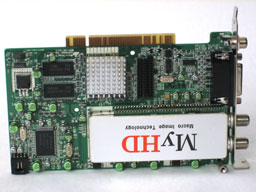

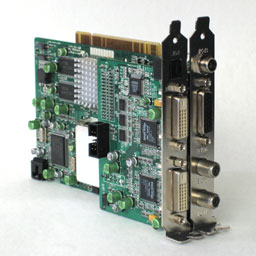
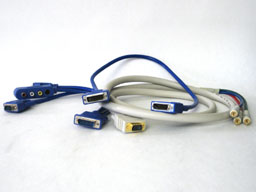








77 Comments
View All Comments
8steve8 - Wednesday, December 7, 2005 - link
bottom line:if i want to watch/record hdtv channels like HBO and/or discover via a PC...
im out of luck?
those channels are not ota... are provided through a cable provider....
i can do this once cable card finally comes around?
JarredWalton - Wednesday, December 7, 2005 - link
HBO and most other movie channels are encrypted. Funny enough, some of the on demand channels seem to be picked up. For instance channels 101-1, 101-2, 102-1, 102-2, and several subchannels on the physical channels 93 and 94 all showed what amounts to random content. Movies, cartoons, and yes, even porn. If you tuned in to one of the channels, sometimes you would see it going to fast-forward mode, like the person watching the content was skipping ahead.Cable card is supposed to allow you to view encrypted content on TVs as well as computers without a set-top box. Until I see it in actual use, though, I'm not exactly sure how it's going to work. I would assume it will just store an encrypted TP file, and the cable card will contain the decryption logic.
nullpointerus - Wednesday, December 7, 2005 - link
http://en.wikipedia.org/wiki/Cablecard">http://en.wikipedia.org/wiki/CablecardI've been waiting for decent HTPC CableCard products for ~2 years now. They'll probably come out very late in 2006, achieve their intended interoperability sometime between the second and third generation of products, and become practically flawless around the same time that they become obsolete. That's just a guess, mind you...
Tujan - Wednesday, December 7, 2005 - link
It was intriging because nobody has really compared the use of DIY HTPCs. With what limited parts are available.I wouldn't use a non-multicore processor for something dealing with HDPCs. Just the shear amount of graphics and screen space,the relative newcomer to its display of screen space,. The notorious 'switching between apps,and those running in the background,- much less using the PCI bus to do so.
What I did miss out of this story,was a shot of a connected MYHD130 to its screen display. Kind of lost me there. With the connect ups to utilizing a screen,and the computers video card. See Im reading imagining toggling between user interface,remote,and what this means to the rigging of separate devices outside the computer itself.Caveat Emptor for/from them along side. And you mentioned that ATI was 'out-of-the-picture , for HDTV unless the components where hooked up. So to share that ATI graphics cards are not useful for the MYHD130.
Would certainly make a wish list to the MYHD130 to put it onto the PCI-e lane.Get it off the PCI bus.
As for those encrypted channels.Are you sure they would stay that way ? Think you could pick out your PPV (Pay-Per-view) channel from that list ? [ ]
You mentioned your Monitor,that they have in common Overscan.I simply have the question included to involve just how a HTPC will correctly recognize a monitor (consider a 32 to 40" LCD TV) ,when most this involves the PNP feature Ive known for doing so.? [ ]
ATI cards aren't any good with the DTV if using the DVI for/from them for the HD screens ? Think 32" to 42" LCD TVs here.[ ]
- glad your doing the experimenting here.Good article.
JarredWalton - Wednesday, December 7, 2005 - link
LCD TVs shouldn't have a problem with overscan. Any rear projection displays will have overscan, and I believe all DLP have overscan as well. There are some good DLP displays that only have 1% overscan, though -- too bad they're really expensive.If you want a picture of what the MyHD looks like when connected, let me see about uploading one and I'll provide a link. This is with the DVI daughter card:
http://images.anandtech.com/reviews/multimedia/tvt...">DVI Passthru Image
http://images.anandtech.com/reviews/multimedia/tvt...">VGA Passthru Image
Hopefully that's clear - there's a lot of cable clutter, so I labeled the pertinent connections.
Tujan - Wednesday, December 7, 2005 - link
Thanks for reply. Even though I know a lot,Im still a novice. Know a lot of the acronymns,but dealing with things marketed off the top just keeps me on to them for a limited span.The picture there,the top card is the video card,with the lower cards being the TV tuners then.Im thinkin that somehow your giving up a controlled connection to your display from the computer by using the MyHD130 ? Or it limits the 'out of your video card when you only would have a single hook up on the Display.[ ]
- I will go to there site to look for more.
Encryption ? [ ] Mean if you subscribe to HBO via your home cable line,HBO will not be able to be seen if utilizing the HTPC with the QAM/HD TV cards ?
Certainly the situation would be averted for the configuration of the cable to Display(cable box to default display) - since (T,F) the Display has an encryption chip within it to do so,(1),or (2) Encryption is handled via the cable box. With everything else dealing with something of the HDCP,HDMI type scenarios.... The encryption mechanism has got to work somewhere in the final render at the Display. Certainly the Cable Company isn't selling me the Display.....
Of course this is a whole nother anchalotta.
I pretty much just look for the configuration compatibility in the input,output for the hookups.And if the software will work/..how difficult to navigate them.
Thinking everythings hunky dory after a large investment ...Again thanks for reply.
JarredWalton - Wednesday, December 7, 2005 - link
Decryption of the encrypted channels is handled by the cable box. The cable card standard will allow other devices to do that decryption -- basically, the key/algorithm will be stored on the cable card. Of course, that means you need to have a TV and or computer that has a cable card slot. Hopefully they'll make a USB adapter.mariush - Wednesday, December 7, 2005 - link
I'm a bit dissapointed that you have used Divx to test the analog recording. XViD would have probably been much faster, at least that's how it is on my computer.Also, I would probably either use XViD set to record with quantizer 1 (max quality) which takes about 6-10 MB/s at 768x576 25fps or I would use a lossless encoder such as HuffYUV (~12 MB/s at 768x576 25fps)
JarredWalton - Wednesday, December 7, 2005 - link
The DivX codec is officially supported by the MyHD software. Xvid was far slower, and that holds in general, unless there is a special setting to get it to encode faster. All the real-time encoding has to be done through a VFW codec, and I couldn't find a fast codec to handle that. The DivX codec is also the only codec that allows you to resize the video content, at least as far as I could tell. Otherwise you end up with an incorrect aspect ratio, as seen on the top left picture on page 15.If you download the videos, you might feel that the DivX codec results in a loss of quality, even on the X2 system. That video sample is actually very close to what you see when watching live analog content with the MyHD card. At best, it's decent analog video. Just about any analog-only TV tuner will produce equal or better output.
Back to the codecs, if you really want to get a decent compression, while not losing a lot of quality, I would recommend using a second PC or re-encoding the videos while your computer is sitting idle. You could do the same thing with the TP files, re-encoding them using the Xvid codec with a data rate of around 1 GB per hour and the target, resolution of 720 x 480 -- or perhaps go for 2/3 GB per hour and target a 1280x1024 resolution.
One of the benefits of the DivX codec is that quite a few consumer-electronics devices now support it as well. I'm not aware of any DVD players that can handle Xvid.
xtknight - Wednesday, December 7, 2005 - link
Sorry for the double post, but by the way, the program AVI.NET can encode xvid and divx for standalone players. That's the whole purpose of it: to use only the features standalone players support. I recommend you try it out.